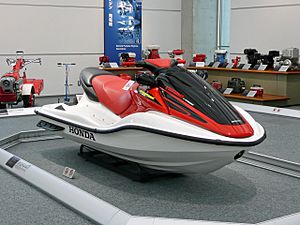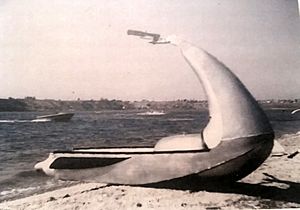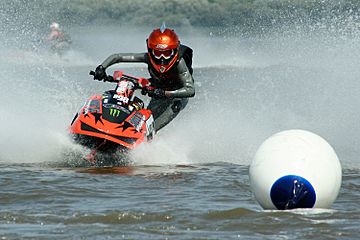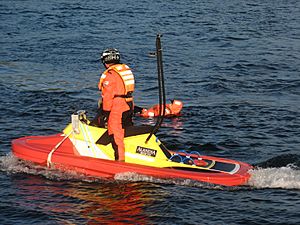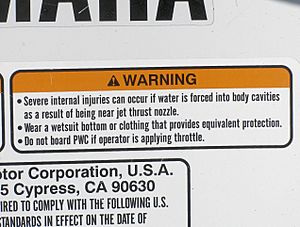Water scooter
A personal watercraft (PWC) is a fun water vehicle you ride on, not inside like a regular boat. People often call them "water scooters" or "jet skis."
There are two main types of PWCs:
- Runabouts: These are the most popular. You sit down to ride them, and they can usually carry two or more people.
- Stand-ups: You stand up to ride these. They are usually for one person and are great for doing cool tricks, racing, or competing.
Both types have an engine inside that powers a special pump. This pump shoots out a strong stream of water to push the PWC forward and help you steer. Most PWCs are made for two or three people, but some bigger ones can hold four. Many newer models can even travel long distances, sometimes over 100 miles (161 km) on one tank of fuel!
You might hear PWCs called by their brand names, like Kawasaki's Jet Ski, Yamaha's WaveRunner, Bombardier's Sea-Doo, or Honda's AquaTrax.
The United States Coast Guard says a PWC is a jet-powered boat shorter than 13 feet (4 m). There are much bigger "jetboats" that are not considered PWCs, some even over 40 feet (12 m) long!
Contents
History of Personal Watercraft
Water scooters first appeared in the United Kingdom and Europe in the mid-1950s. Early models included the British Vincent Amanda and the German Wave Roller. Thousands of Vincent Amandas were sent to places like Australia, Asia, Europe, and the United States.
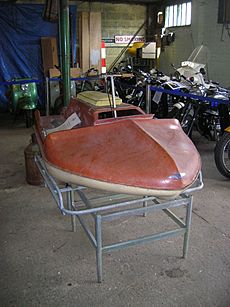
In 1961, the Sea Skimmer was introduced. It was like a propelled surfboard, about 5 feet 6 inches long. It had an engine and could go up to 25 MPH. The rider would lie on it, using hand controls for speed and their feet to steer. This design was later used by the military for river missions.
The idea of a personal watercraft was further developed in the 1960s by Clayton Jacobson II from Lake Havasu City, Arizona, USA. Clayton loved motocross, and he wanted to create a similar experience on water. His first working model in 1965 was made of aluminum and had a fixed, upright handle. A year later, he made a second model out of fiberglass.
The first PWC like Clayton's to be sold was made by Bombardier in the late 1960s. However, these early designs weren't very popular, and Bombardier stopped making them before 1970.
In Greece, an inventor named Dimitrios T. Moraitidis also built a prototype and got a patent for it in 1970. He never sold his invention.
Stand-up PWCs were first mass-produced by the Japanese company Kawasaki in 1972, under the famous Jet Ski brand. They arrived in the US in 1973. While stand-up models are still made today, the sit-down "runabout" style became much more popular.
Many companies started making sit-down runabouts, including Kawasaki (Jet Ski), Bombardier (Sea-Doo), Yamaha (WaveRunner), Honda (AquaTrax), Polaris (Sealion), and Arctic Cat (Tigershark). By 2010, the main PWC makers were Kawasaki, Bombardier, and Yamaha.
PWC Sports and Racing
PWC racing is a big sport around the world! There are different kinds of races and events:
- Closed Circuit Speed Races: Riders race on a marked course.
- Offshore Speed Races: These are races on open water.
- Endurance Races: Long races that test how long riders and their PWCs can last.
- Freestyle: Riders perform amazing tricks and stunts.
- Freeride: Similar to freestyle, often done in natural wave conditions.
For most speed races, PWCs are put into categories based on how much they've been changed from their original design. "Stock" means minor changes, "limited" means some changes, and "F1" means lots of changes for maximum speed. In freestyle and freeride, riders are grouped by whether they use a stand-up or sit-down PWC.
The main organization for powerboat sports, including PWC racing, is the U.I.M.. They are recognized by the IOC. The official world series, called the Aquabike World Championship, started in 1996. This championship is known for having many different countries compete, with up to 32 nationalities and 140 riders in some events!
Other private competitions also exist, like P1 AquaX. This racing series started in the UK in 2011 and later expanded to the USA. It has attracted hundreds of riders from many countries.
In the United States, the main groups that organize PWC racing are the International Jet Sport Boating Association (IJSBA) and Pro Watercross (PWX). The IJSBA World Finals are usually held in Lake Havasu City, Arizona, in October. The Pro Watercross World Finals are typically in Naples, Florida, in November.
Other Uses for Personal Watercraft
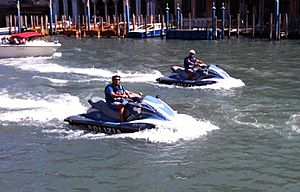
PWCs are small, fast, easy to handle, and fairly affordable. Their special propulsion system doesn't have outside propellers, which can make them safer than small motorboats for swimmers and wildlife. Because of these features, PWCs are used for more than just fun:
- Fishing: Fishing from a PWC is becoming very popular!
- Lifeguards: Lifeguards use PWCs with rescue platforms to quickly reach people in trouble in the water or to help flood survivors.
- Police and Rangers: Law enforcement uses them to patrol coastal waters, lakes, and rivers.
- Coaching: Some coaches for rowing sports use PWCs with special equipment to give instructions and measure distances.
- Military: The U.S. Navy even uses PWCs as targets for practice! They can be controlled remotely and are small enough to be carried on many different ships.
Cleaner Personal Watercraft
Before 1991, there were no rules about how much pollution PWCs could create in the United States. Many older PWCs used a type of engine called a "two-stroke" engine. These engines were smaller and lighter, but they released more pollution into the air and water. They would mix oil with their fuel, and a lot of that fuel and oil would come out unburned in the exhaust.
In the 1990s, new laws allowed the U.S. Environmental Protection Agency to start making rules for all recreational boat engines, including PWCs. After talking with manufacturers, rules were put in place in 1996. These rules slowly came into effect between 1998 and 2006. They allowed manufacturers to make some engines cleaner to balance out others that might pollute more. California and New York later made even stricter rules.
To meet these new rules, PWC makers made many improvements. They started using more "four-stroke" engines, which are much cleaner. They also added special systems like direct injection for two-stroke engines and catalytic converters. Overall, these changes have reduced pollution from new PWCs by about 75% compared to older models!
Some places, like Lake Tahoe, only allow PWCs that meet these newer, cleaner standards. This includes all four-stroke models and some two-stroke models with special direct-injection systems.
Safety on Personal Watercraft
Riding a PWC is exciting, but it's important to be aware of some safety risks, just like with any vehicle.
One unique risk is from the powerful jet of water that propels the PWC. If you're not wearing strong, thick clothing like a wetsuit, this jet can cause injuries to your lower body if you fall off. All major PWC makers warn about this and suggest wearing wetsuit bottoms or similar protection.
Another important safety point is "off throttle steering." In some PWC models, if you let go of the throttle (the gas), you can't steer! This means you can't turn if the engine isn't pushing water out. This can be very dangerous and lead to serious accidents.
Jumping over waves or wakes can be fun, but it can also cause spinal injuries. PWC manuals warn against jumping too high, especially if you've had back problems before. They say, "Jumping wakes or waves can increase the risk of spinal/backbone injuries (paralysis)." It's always best to slow down before crossing waves.
Also, be careful around the intake grate (where the water gets sucked into the pump). The warnings say, "Keep away from Intake Grate while the engine is on." Things like long hair, loose clothing, or life vest straps can get caught in the moving parts, which could cause serious injury or even drowning.
Sadly, there have been fatal accidents involving PWCs. For example, U.S. astronaut Alan G. Poindexter passed away in 2012 from injuries he got in a Jet Ski accident. Always follow safety rules and wear the right gear to stay safe!
Images for kids
-
Even the largest PWCs, like the Sea-Doo LRV, can be easily loaded onto a trailer and moved from one lake or ocean to another.
See also
 In Spanish: Moto de agua para niños
In Spanish: Moto de agua para niños
- Aqua scooter (an older type of water scooter)
- Flyboard
- Video games featuring personal watercraft:
- Jet X2O
- Splashdown
- Wave Race
- Wave Race 64
- Wave Race: Blue Storm
- Wetbike
- Yamaha Superjet
- Yamaha Wave Blaster
- Belassi Hypercraft


